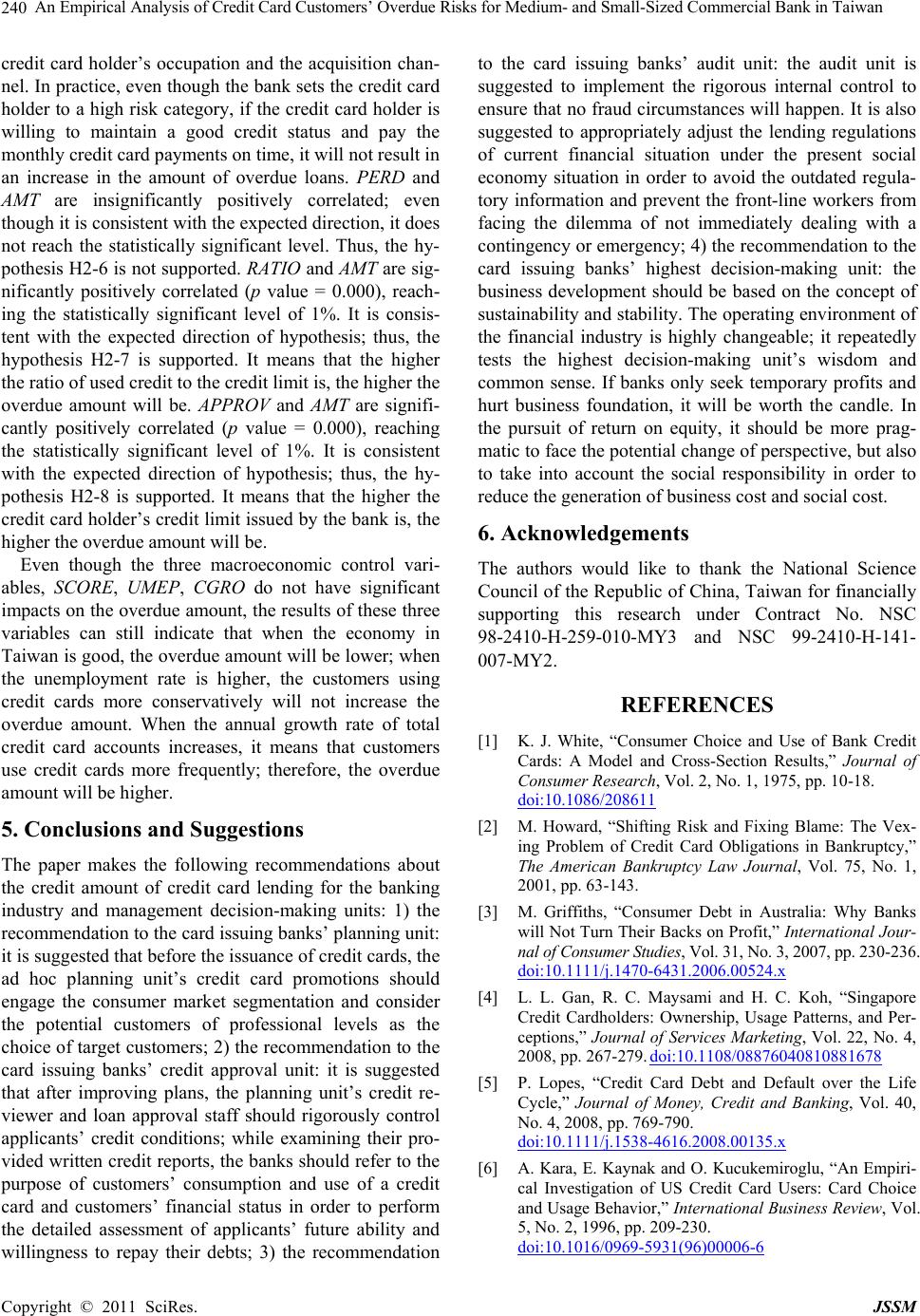
An Empirical Analysis of Credit Card Customers ’ Overdue Risks for Medium - and Small-Sized Commercial Bank in Taiwan
Copyright © 2011 SciRes. JSSM
240
credit card holder’s occupation and the acquisition chan-
nel. In practice, even though the bank sets the credit card
holder to a high risk category, if the credit card holder is
willing to maintain a good credit status and pay the
monthly credit card payments on time, it will not result in
an increase in the amount of overdue loans. PERD and
AMT are insignificantly positively correlated; even
though it is consistent with the expected direction , it does
not reach the statistically significant level. Thus, the hy-
pothesis H2-6 is not supported. RATIO and AMT are sig-
nificantly positively correlated (p value = 0.000), reach-
ing the statistically significant level of 1%. It is consis-
tent with the expected direction of hypothesis; thus, the
hypothesis H2-7 is supported. It means that the higher
the ratio of used credit to the credit limit is, the higher the
overdue amount will be. APPROV and AMT are signifi-
cantly positively correlated (p value = 0.000), reaching
the statistically significant level of 1%. It is consistent
with the expected direction of hypothesis; thus, the hy-
pothesis H2-8 is supported. It means that the higher the
credit card holder’s credit limit issued by the bank is, the
higher the overdue amount will be.
Even though the three macroeconomic control vari-
ables, SCORE, UMEP, CGRO do not have significant
impacts on the overdue amount, the results of these three
variables can still indicate that when the economy in
Taiwan is good, the overdue amount will be lower; when
the unemployment rate is higher, the customers using
credit cards more conservatively will not increase the
overdue amount. When the annual growth rate of total
credit card accounts increases, it means that customers
use credit cards more frequently; therefore, the overdue
amount will be higher.
5. Conclusions and Suggestions
The paper makes the following recommendations about
the credit amount of credit card lending for the banking
industry and management decision-making units: 1) the
recommendation to th e card issuing b anks’ planning unit:
it is suggested that before the issuance of credit cards, the
ad hoc planning unit’s credit card promotions should
engage the consumer market segmentation and consider
the potential customers of professional levels as the
choice of target customers; 2) the recommendation to the
card issuing banks’ credit approval unit: it is suggested
that after improving plans, the planning unit’s credit re-
viewer and loan approval staff should rigorously control
applicants’ credit conditions; while examining their pro-
vided written credit reports, the bank s should refer to the
purpose of customers’ consumption and use of a credit
card and customers’ financial status in order to perform
the detailed assessment of applicants’ future ability and
willingness to repay their debts; 3) the recommendation
to the card issuing banks’ audit unit: the audit unit is
suggested to implement the rigorous internal control to
ensure that no fraud circumstances will happen. It is also
suggested to appropriately adjust the lending regulations
of current financial situation under the present social
economy situation in order to avoid the outdated regula-
tory information and prevent the front-line workers from
facing the dilemma of not immediately dealing with a
contingency or emergency; 4) the recommendation to the
card issuing banks’ highest decision-making unit: the
business development should be based on the concept of
sustainability and stability. The op erating environment of
the financial industry is highly changeable; it repeatedly
tests the highest decision-making unit’s wisdom and
common sense. If banks only seek temporary profits and
hurt business foundation, it will be worth the candle. In
the pursuit of return on equity, it should be more prag-
matic to face the potential change of perspective, but also
to take into account the social responsibility in order to
reduce the generation of business cost and social cost.
6. Acknowledgements
The authors would like to thank the National Science
Council of the Republic o f China, Taiwan for financially
supporting this research under Contract No. NSC
98-2410-H-259-010-MY3 and NSC 99-2410-H-141-
007-MY2.
REFERENCES
[1] K. J. White, “Consumer Choice and Use of Bank Credit
Cards: A Model and Cross-Section Results,” Journal of
Consumer Research, Vol. 2, No. 1, 1975, pp. 10-18.
doi:10.1086/208611
[2] M. Howard, “Shifting Risk and Fixing Blame: The Vex-
ing Problem of Credit Card Obligations in Bankruptcy,”
The American Bankruptcy Law Journal, Vol. 75, No. 1,
2001, pp. 63-143.
[3] M. Griffiths, “Consumer Debt in Australia: Why Banks
will Not Turn Their Backs on Profit,” International Jour-
nal of Consumer Studies, Vol. 31, No. 3, 2007, pp. 230-236.
doi:10.1111/j.1470-6431.2006.00524.x
[4] L. L. Gan, R. C. Maysami and H. C. Koh, “Singapore
Credit Cardholders: Ownership, Usage Patterns, and Per-
ceptions,” Journal of Services Marketing, Vol. 22, No. 4,
2008, pp. 267-279. doi:10.1108/08876040810881678
[5] P. Lopes, “Credit Card Debt and Default over the Life
Cycle,” Journal of Money, Credit and Banking, Vol. 40,
No. 4, 2008, pp. 769-790.
doi:10.1111/j.1538-4616.2008.00135.x
[6] A. Kara, E. Kaynak and O. Kucukemiroglu, “An Empiri-
cal Investigation of US Credit Card Users: Card Choice
and Usage Behavior,” International Business Review, Vol.
5, No. 2, 1996, pp. 209-230.
doi:10.1016/0969-5931(96)00006-6